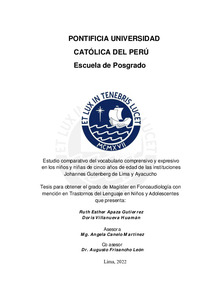| dc.contributor.advisor | Canelo Martinez, Angela | |
| dc.contributor.advisor | Frisancho León, Augusto | |
| dc.contributor.author | Apaza Gutierrez, Ruth Esther | |
| dc.contributor.author | Villanueva Huamán, Doris | |
| dc.date.accessioned | 2022-10-15T00:11:03Z | |
| dc.date.available | 2022-10-15T00:11:03Z | |
| dc.date.created | 2022 | |
| dc.date.issued | 2022-10-14 | |
| dc.identifier.uri | http://hdl.handle.net/20.500.12404/23573 | |
| dc.description.abstract | La presente investigación titulada “Estudio comparativo del vocabulario
comprensivo y expresivo en los niños y niñas de cinco años de edad de las
instituciones Johannes Gutenberg de Lima y Ayacucho”, tiene por objetivo
determinar las diferencias en el vocabulario que presentan los niños participantes
del estudio. Esto servirá como información relevante para los profesionales debido
a las escasas investigaciones en dos contextos distintos. Para lograr tal propósito,
se revisó bibliografía especializada relacionada al tema de estudio, hallándose que
el grupo de niños de zonas urbanas obtienen mejores resultados que los niños de
zonas rurales. En esta investigación se usó el enfoque cuantitativo a fin de recolectar
y analizar datos que prueben las hipótesis establecidas. El método es descriptivo
porque predominan las características de las variables vocabulario comprensivo y
expresivo, es comparativo porque se contrasta el rendimiento de las variables y su
relación en función del lugar de procedencia y del sexo. Presenta una muestra de
60 niños y niñas, 30 de Lima y 30 de Ayacucho seleccionados en la modalidad
intencional en distritos de Comas y Huanta respectivamente. En el proceso de
medición de ambas variables se utiliza el Test de vocabulario en imágenes de
PEABODY PPVT III y el Test Figura – Palabra de vocabulario expresivo de
Gardner – Adaptado. Los resultados señalan que no existen diferencias
significativas en el desarrollo del vocabulario comprensivo, en relación al lugar de
procedencia y sexo. En el vocabulario expresivo se evidencia una diferencia según
el lugar de procedencia, más no en la variable sexo. | es_ES |
| dc.description.abstract | The present research entitled "Comparative study of comprehensive and
expressive vocabulary in five-year-old boys and girls of the Johannes Gutenberg
Institutions of Lima and Ayacucho", aims to determine the differences in the
vocabulary presented by the children participating in the study. This will serve as
relevant information for professionals due to scarce research in two different
contexts. To achieve this purpose, specialized bibliography related to the subject of
study was reviewed, finding that the group of children from urban areas obtains
better results than children from rural areas. In this research, the quantitative
approach was used in order to collect and analyze data that prove the established
hypotheses. The method is descriptive because the characteristics of the variables
of sympathetic and expressive vocabulary predominate, it is comparative because
the performance of the variables is contrasted and their relation according to the
place of origin and sex. It presents a sample of 60 boys and girls, 30 from Lima and
30 from Ayacucho selected in the intentional modality of the district of Comas and
Huanta respectively. In the process of measuring both variables, the Vocabulary
Test in images of PEABODY PPVT III and the Test Figure - Gardner's Expressive
Vocabulary Word - Adapted. The results indicate there are no significant
differences in the development of the comprehensive vocabulary, in relation to the
place of origin and sex. In the expressive vocabulary a difference is evidenced
according to the place of origin, but not in the variable sex. | es_ES |
| dc.language.iso | spa | es_ES |
| dc.publisher | Pontificia Universidad Católica del Perú | es_ES |
| dc.rights | info:eu-repo/semantics/openAccess | es_ES |
| dc.rights | Atribución-NoComercial-SinDerivadas 2.5 Perú | * |
| dc.rights | Atribución-NoComercial-SinDerivadas 2.5 Perú | * |
| dc.rights.uri | http://creativecommons.org/licenses/by-nc-nd/2.5/pe/ | * |
| dc.rights.uri | http://creativecommons.org/licenses/by-nc-nd/2.5/pe/ | * |
| dc.subject | Vocabulario--Test | es_ES |
| dc.subject | Niños--Lenguaje | es_ES |
| dc.subject | Educación preescolar--Perú--Lima--Investigaciones | es_ES |
| dc.subject | Educación preescolar--Perú--Ayacucho--Investigaciones | es_ES |
| dc.title | Estudio comparativo del vocabulario comprensivo y expresivo en los niños y niñas de cinco años de edad de las instituciones Johannes Gutenberg de Lima y Ayacucho | es_ES |
| dc.type | info:eu-repo/semantics/masterThesis | es_ES |
| thesis.degree.name | Magíster en Fonoaudiología con mención en Trastornos del Lenguaje en Niños y Adolescentes | es_ES |
| thesis.degree.level | Maestría | es_ES |
| thesis.degree.grantor | Pontificia Universidad Católica del Perú. Escuela de Posgrado. | es_ES |
| thesis.degree.discipline | Fonoaudiología con mención en Trastornos del Lenguaje en Niños y Adolescentes | es_ES |
| renati.advisor.dni | 41639595 | |
| renati.advisor.dni | 07291486 | |
| renati.advisor.orcid | https://orcid.org/0000-0002-0069-8395 | es_ES |
| renati.author.dni | 10881545 | |
| renati.author.dni | 40240528 | |
| renati.discipline | 916137 | es_ES |
| renati.juror | Sandoval Palacios, Marcela Maria | es_ES |
| renati.juror | Canelo Martinez, Angela | es_ES |
| renati.juror | Ortiz De Orué Aliaga, Julia Vanessa | es_ES |
| renati.level | https://purl.org/pe-repo/renati/level#maestro | es_ES |
| renati.type | https://purl.org/pe-repo/renati/type#tesis | es_ES |
| dc.publisher.country | PE | es_ES |
| dc.subject.ocde | https://purl.org/pe-repo/ocde/ford#5.03.02 | es_ES |






